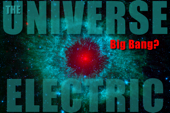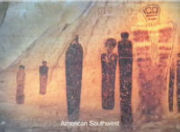The Tangled Web of Today's Cosmology...
08/17/08
It seems that recent results from the Sloan Digital Sky Survey
(SDSS-II) have taken something simple and complicated it. Specifically,
the Milky Way’s outer stellar halo has been mapped to higher precision,
revealing tangled filaments of stars wrapped around the galaxy.

Are the stars of the Milky Way’s halo organized and energized electrically,
not unlike bulbs on a string of Christmas lights?
A recent
news release about the latest results from the SDSS-II project offers some
tantalizing revelations about the structure of our galaxy.
The halo of stars that envelops the Milky Way galaxy is like a river delta
criss-crossed by stellar streams large and small, according to new data from
the Sloan Digital Sky Survey (SDSS-II). While the largest rivers of this delta
have been mapped out over the last decade, analysis of the new SDSS-II map
shows that smaller streams can be found throughout the stellar halo.
The halo is apparently composed of “rivers” and “streams”
of stars. What they’re saying is that the stars in the halo are organized along
filaments. There is structure to the halo, as opposed to a simple random jumble
of points. Moreover, the filaments are tangled and interconnected, like a web
or a ball of Christmas lights.
"A jumble of pasta" is the way Columbia University researcher Kathryn
Johnston described her theoretical models of the Milky Way's stellar halo.
However, the only model that most astronomers currently have to go on is a
gravity-dominated paradigm of Einstein and Newton, eschewing any talk about
the more powerful raw electric forces at play in the universe.
Under gravity-only assumptions, the filaments (much like x-rays, and peculiar
galaxies in other astronomical settings) must arise from galaxy mergers, collisions
or extremely close calls where the stars were gravitationally stripped from a
nearby galaxy and laced around the outer fringes of ours.
In support of this idea, astronomers have alluded to the recently discovered
“finger” of “hot gas” (plasma)
connecting the Milky Way to the Large Magellanic Cloud (and possibly beyond).
That’s all well and good, if one believes that the gravity-only model is the only
model with something to say about the issue.
However, other opinions do exist.
Plasma cosmology recognizes the fact that
99.999% of visible matter in the universe is in the
plasma state. Plasma is a highly conductive medium (though not a perfect conductor)
through which electric currents can flow.
Magnetic fields are indicative of electric currents, as noted in the Wikipedia entry on
electric current.
Electric current produces a magnetic field. The magnetic field can be visualized as
a pattern of circular field lines surrounding the wire. Electric current can be directly
measured with a galvanometer, but this method involves breaking the circuit, which
is sometimes inconvenient. Current can also be measured without breaking the circuit
by detecting the magnetic field associated with the current.
The strength of the magnetic field is dependent on the strength of the source
electric currents, as noted in the succinct
summary on the World Health Organization’s web site.
Electric fields are created by differences in voltage: the higher
the voltage, the stronger will be the resultant field. Magnetic fields
are created when electric current flows: the greater the current, the stronger the
magnetic field.
[…]
If current [flows], the strength of the magnetic field will vary with power
consumption but the electric field strength will be constant.
Magnetic fields are seen ubiquitously throughout the cosmos. By simple definition,
plasma cosmologists understand that electric currents must therefore also flow
throughout the cosmos. Keeping these basic facts in minds, plasma cosmologists
believe that the universe is threaded with and structured by filaments of electrified
plasma at all scales.
Plasma processes known from the lab can be scaled upward to cosmic dimensions
according to specific scaling laws in order to give us insight into the physical
processes taking place in remote locations observed by our modern optical, radio,
UV, x-ray and gamma ray telescopes.
Plasma cosmologists recognize the filamentary strands threading the galactic halo
as yet more anecdotal evidence for the electric currents they believe thread and
energize the universe. However, one piece of evidence does not a convincing case
make.
Luckily, there are plentiful other lines of evidence showing both the fractal and
filamentary nature of the universe (on both small and large scales) and of electrical
processes (with magnetic field byproducts) therein.
In our own solar system,
“magnetic
flux ropes” (
650,000 Amp electric currents) connect the Earth and the Sun, energizing the auroras.
Io is embroiled in a
million Amp,
2 trillion watt “flux tube” (electric current) of its own with Jupiter,
landing footprints in the
high voltage auroras (10 million volts, 10 million Amps and 100 terawatts) of
both hemispheres of the gas giant. Moreover, new research suggests that there is
actually an
electron beam transferring current from one hemisphere of Jupiter to the other.
Furthermore, Europa and Ganymede have similar
auroral footprints and are likely embroiled in similar electrical interactions
with Jupiter to those of their sibling Io. Meanwhile, a
prior Thunderblog has suggested that a similar interaction is occurring between
Enceladus and Saturn.
Earth itself acts as a leaky, self-repairing
spherical capacitor immersed in the sun’s plasma environment, as noted in a prior
TPOD. Telluric currents flow underground through
6000 km of the Australian outback, from the pacific into
North America and elsewhere. Lightning crackles between the clouds and the Earth.
As well, upper atmospheric discharges (such as
blue jets,
gigantic jets,
sprites,
ELVES and
TIGERs) reach from the cloud tops toward space.
With such evidence in hand, it should no longer seem strange to consider the idea
that Earth inevitably interacts with the conductive plasma of space or that electric
currents (such as
Birkeland currents or “field-aligned currents”) can flow through it.
Since electric currents in plasma tend to adopt a
filamentary structure, it should be little surprise that plasma cosmologists
do not see “torsion waves along magnetic fields anchored in the accretion
disk of a black hole” (treating magnetic fields like a slinky that can be
shaken or twirled) when viewing images of the
Double-Helix Nebula (sometimes called the DNA Nebula due to its resemblance to
the double helix of DNA). Rather, they see a pair of electric currents spiraling
around one another, not unlike the filaments of a novelty plasma lamp (scaled up
to cosmic dimensions). The magnetic fields present are simply a byproduct of the
pair of intertwined currents.
Beyond the galactic level, plasma cosmologists expect the universe to be a gigantic
fractal web of
interconnected filaments consisting of electrified plasma. Their contention is
that galaxies are born along these interacting filaments. And, in fact, that appears
to be borne out by
recent discoveries. Moreover, even galaxy clusters appear to be connected one to
the next by gigantic ropes of plasma.
A universe with fractal structure at the largest scales is a
fatal problem for the standard model.
If this dissenting view is correct and the Universe doesn't become smoothed out
on the very largest scales, the consequences for cosmology are profound.
"We're lost," says Coles. "The foundations of the big bang models
would crumble away. We'd be left with no explanation for the big bang, or galaxy
formation, or the distribution of galaxies in the Universe."
It is, however, a prediction of plasma cosmology. Recent data, also from SDSS,
appears to tentatively suggest a large-scale
fractal distribution of matter in the universe.
In an amusing twist from the above article, astronomers attempt to stick their
heads in the sand:
Many cosmologists find fault with their analysis, largely because a fractal
matter distribution out to such huge scales undermines the standard model of
cosmology.
Unfortunately that’s quite unscientific, tantamount to saying “I disagree
without your data because your data falsifies my theory.”
It’s also reminiscent of one of Einstein’s more unfortunate
quotes:
If the facts don't fit the theory, change the facts.
[ ! ]
A dangerous doctrine indeed! One cannot set aside disconfirming data simply
because one does not wish to be wrong.
In any event, a picture of the universe begins to emerge from the seeming
chaos. The picture is one in which the universe is threaded by electrified
filaments of plasma, birthing galaxies and within the galaxies their stars.
If stars are the focal points of interstellar currents, they also appear to
offload some of the current to their satellites (planets), which may well
offload some of their received currents to their own satellites (moons like
Io, Europa, Ganymede, Enceladus, etc.). Planets and moons may also undergo
internal or external energetic processes owing to the currents fed into
them along their magnetic fields.
The recent release about the rivers and streams of stars (and most likely
plasma as well) in the Milky Way’s stellar halo appears to fit neatly into
the plasma cosmology model. It just remains for astronomers to take heed
of the plasma cosmologists, plasma physicists and electrical engineers who
would like to help them better understand the goings on “out there,
” and find real answers using the physics we’re already familiar with
rather than postulating unproven “new physics” like dark matter,
dark energy, inflation, et al.
Michael Gmirkin
Permalink to this article.
Public comment may be made on this article on the
Thunderbolts Forum/Thunderblogs (free membership required).
|

Michael Gmirkin is a technology enthusiast with a keen interest
in exploring the electrical nature of the universe.
My Archives
Chronological Archives
Archives by Author
Archives by Subject
Thunderblogs home
|





